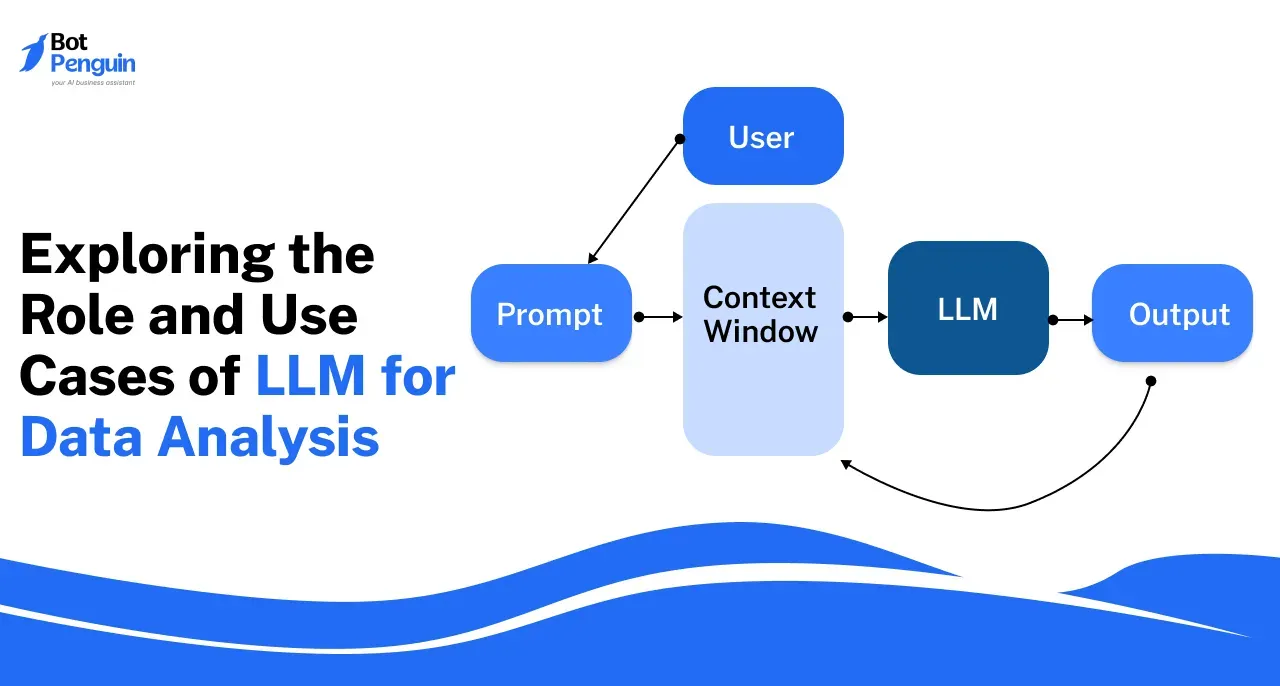Introduction
In businesses, you cannot make decisions based on instinct or guesses. You need concrete data to support your actions and this is where LLM for data analysis comes into the picture.
They help organizations make informed decisions by providing them with valuable insights like facts, statistics, and trends.
However, due to increased competition, the volume and complexity of these datasets also grow. Hence, businesses are actively searching for innovative solutions that can help them gain valuable information from various sources.
In this guide, we will explore the role, and use cases of LLM for data analysis. But before proceeding let us look at some basics of these concepts to understand the context better.
Basics of LLMs
LLM is a type of AI that can be trained using vast amounts of text data. They can generate text that appears human-like and can interpret the context of words and sentences.
Their understanding capabilities are improved using pre-trained datasets.
LLMs use deep learning methods and can predict the next word in a sentence, comprehend grammar, and even generate a complete paragraph. Their other capabilities include understanding prompts, engaging in meaningful conversations, producing creative content, and summarizing content.
A popular example is GPT-4 which is an LLM and can execute various language-related tasks with great accuracy.
Basics of Data Analysis

As the name suggests, in data analytics, you can analyze huge amounts of datasets to gain valuable insights on patterns, trends, and other important information. This helps you to make informed decisions in business.
With the help of machine learning, deep learning, and statistical methods, businesses can understand how successful their strategies are, the satisfaction rate of customers, and ways to boost their revenues.
Simply put, you can use data analytics to provide personalized experiences to customers, increase brand loyalty, and also generate profits.
Using LLM for Data Analysis
LLM for data analysis is a powerful combination to unlock potential insights for businesses.
You can use LLM for data preprocessing tasks like cleaning, organizing, and creating visualizations to present the data in an appealing and understandable format.
Businesses can use LLM data analysis to integrate structured and unstructured data which helps them to understand customer sentiments, market trends, and emerging patterns.
For example, you can use LLM to analyze data like customer reviews, or social media posts that fall under the unstructured data category. It gets valuable insights from this data.
When this is combined with structured data like purchase history or customer demographics, businesses can understand customer preferences, market dynamics, and the overall performance of their products or services. Hence, LLM data analysis plays a key role in businesses.
LLMs in Predictive Analytics
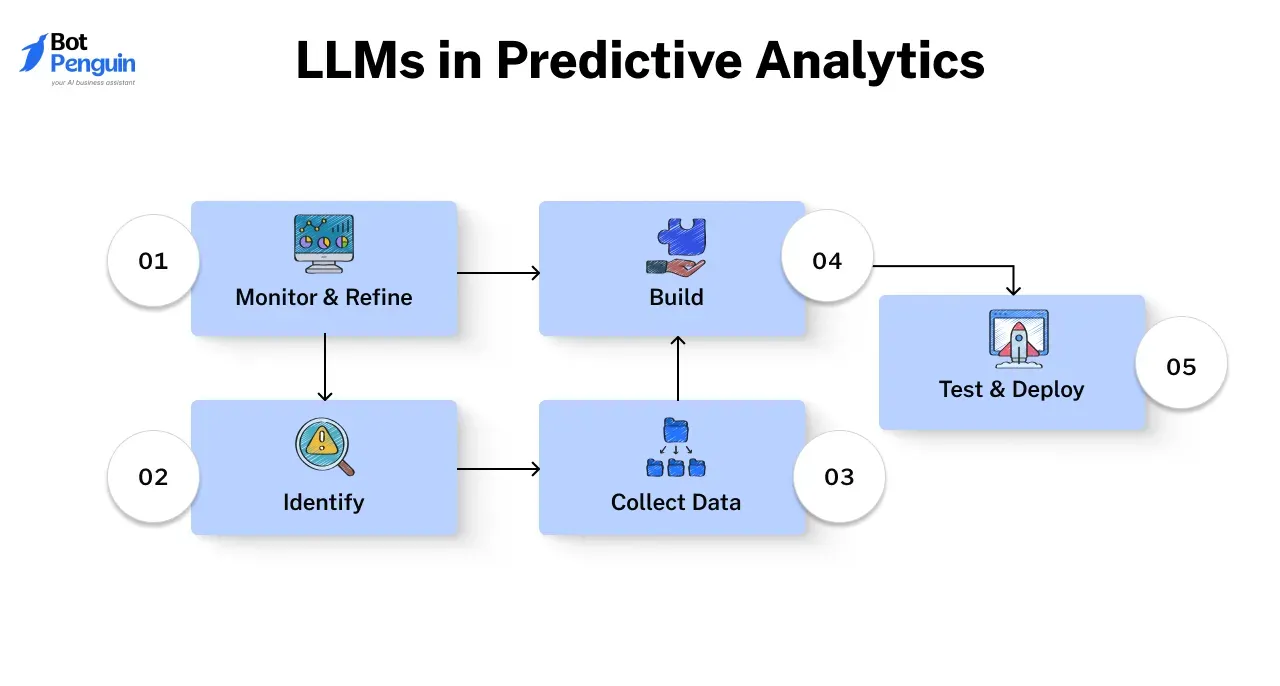
Predictive analysis is also a type of data analysis. It uses past data, statistical records, and machine-learning techniques to predict future trends and customer behaviors.
When used in businesses, it helps them to recognize potential risks, optimize processes, and stay one step ahead of their competitors.
When LLM analytics are used in predictive analysis, they help perform sentiment analysis and understand the context of textual data. This improves the accuracy and depth of predictive analysis.
Also, LLMs can help predictive analysis with their language processing abilities. They can analyze text data in massive volumes and provide insights that can be used in predictive modeling.
This powerful combination of predictive analysis and LLM analytics allows businesses to make informed, data-driven decisions with a better understanding of customer and market trends.
Use Cases of LLM for Data Analysis
LLM for data analysis is transforming the way organizations approach and use data. By integrating natural language processing capabilities, LLMs streamline workflows, enhance insights, and empower decision-making.
Here’s a detailed look at the most impactful use cases of LLMs across the data analysis lifecycle.
Sentiment Analysis
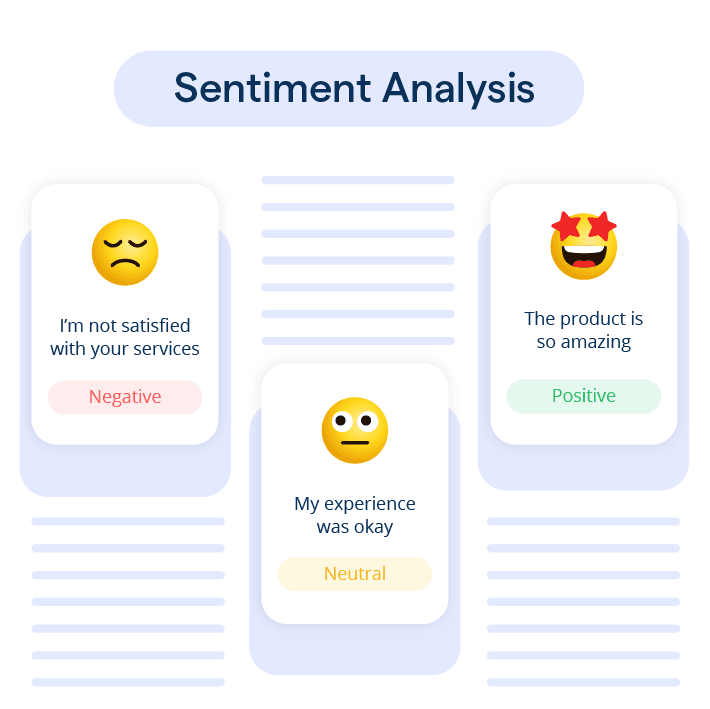
Using LLM for data analysis helps to understand the context and sentiments of textual data. Hence, businesses can adopt them to analyze customer feedback and monitor brand reputation.
This will allow them to connect with customers on a more personal level. They can provide better personalized recommendations to customers, and adapt well to the emerging market trends.
Also, with the help of sentiment analysis, businesses can maintain their brand's image and voice. Also, if there is a potential threat to their reputation, they can address it immediately.
Trend Analysis
LLM model for data analysis helps businesses analyze blogs and social media discussions to understand and recognize emerging trends and customer preferences.
The model interprets important topics and sentiments from textual data which can help businesses to become aware of the market changes and customer behavior.
Hence, they can refine their products, and marketing campaigns, and manage their inventories efficiently. This can ultimately result in a sales increase.
Risk Analysis
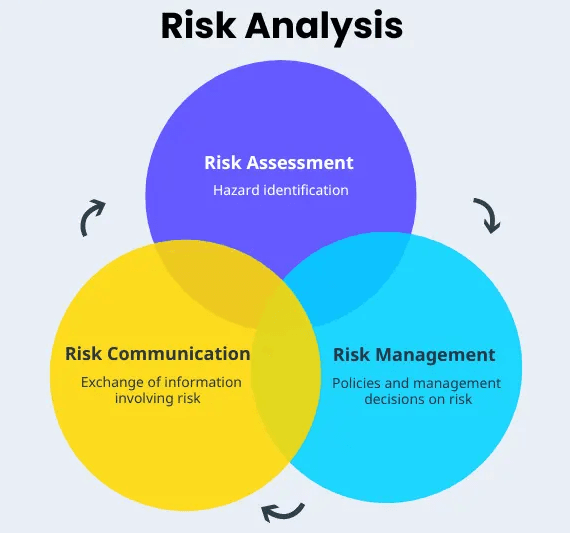
LLM model for data analysis allows businesses to analyze transaction records, applications, online interactions, and customer messages. This can help them identify fraudulent activities and reduce potential risks.
It can also recognize unusual patterns and highlights the risks which can reduce financial losses and provide increased security.
The use cases above indicate how LLMs enable businesses to proactively mitigate risks, improve security measures, and reduce financial losses by detecting fraudulent patterns and unusual activities.
Advantages of LLMs for Data Analysis
Large language models (LLMs) have redefined how we approach data analysis.
By leveraging their capabilities, tasks that once required specialized skills can now be done efficiently with minimal effort. Here is how LLM for data analysis creates value and simplifies workflows.
- Scalability: LLM model for data analysis enables the processing of huge datasets rapidly. This can help businesses that are in need of such requirements. They can process the data efficiently and produce quality outputs.
- Accuracy: LLM uses deep learning algorithms that help provide accurate results without any comprise in performances. Hence, when businesses use LLM for data analysis, they acquire meaningful insights and use them effectively.
- Cost Efficiency: Using LLM for data analysis can prove to be cost-effective eventually. Though businesses have to invest a larger fee for model preparation and training, once implemented, it automates repetitive tasks and streamlines the processes.
Hence, LLMs help businesses save time, reduce operational costs, and maximize overall efficiency.
Limitations of LLM for Data Analysis
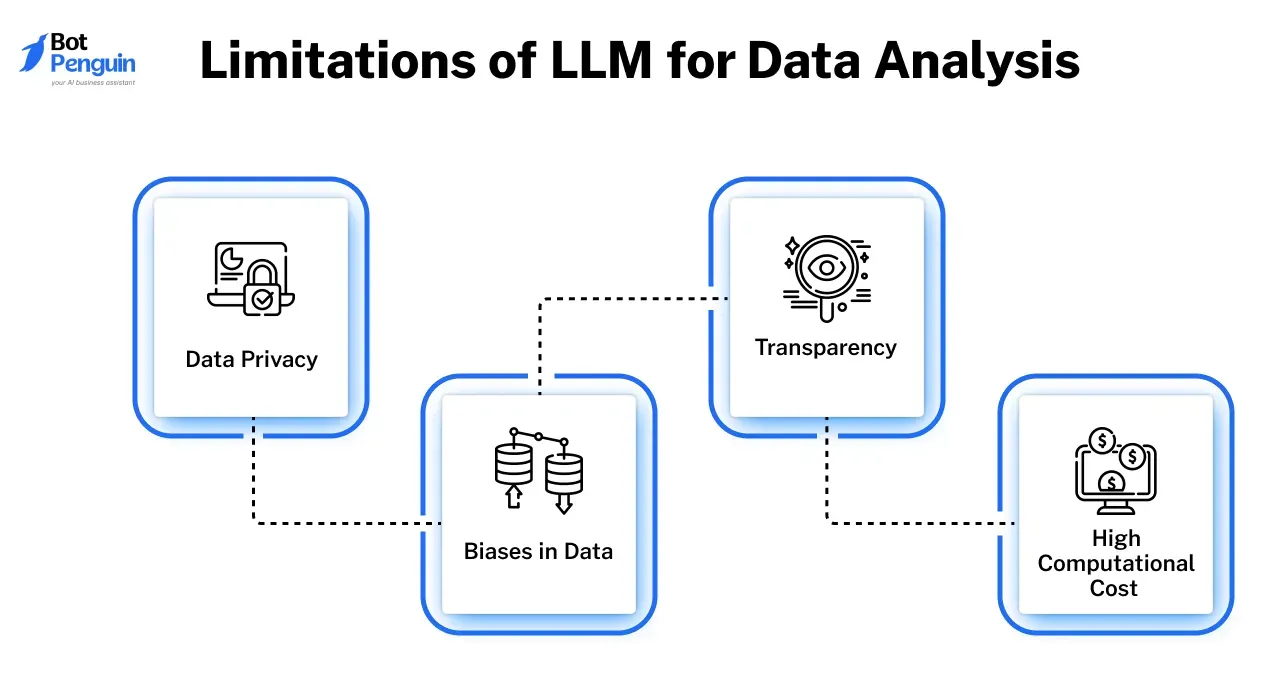
While LLM for data analysis offers transformative capabilities, it is not without its limitations.
Understanding these challenges is crucial for effectively leveraging LLMs in real-world scenarios. Below, we explore the primary constraints that businesses and analysts may encounter when relying on LLMs.
Data Privacy
One of the major concerns while using LLM for data analysis is data privacy. The model requires massive amounts of training data to produce the desired output.
Hence, while providing sensitive data, businesses must adhere to privacy rules.
Biases in Data
Another concern while using LLM for data analysis is potential bias. While feeding the training data, some source materials may contain biases.
Hence, businesses should provide quality training data and also implement methods to detect and minimize biases. This also ensures the output can be trusted by customers.
Transparency
This is another concern that businesses encounter when using LLM for data analysis. They find it challenging to understand the decisions made by the model.
Hence, they have to find methods with which they can interpret the reason for the decisions, thereby building confidence to trust the results.
High Computational Cost
High computational resources are required to train an LLM model for data analysis. It consumes lots of energy and needs a powerful computing infrastructure.
Hence, businesses need to address the environmental impact and use resources effectively without affecting performance.
To overcome these limitations successfully, businesses should use their resources efficiently, and consider environmental impacts and performance, which allows them to maximize the benefits of LLMs.
How to Choose the Right LLM for Data Analysis?
Selecting the right LLM for data analysis can significantly impact your ability to extract insights efficiently and effectively.
With various models available, it is essential to evaluate key factors to ensure the best fit for your needs. Below are the critical considerations and examples of popular models to guide your decision.
Dataset Size and Structure
It is essential to understand your dataset. If your data is primarily unstructured, like text or logs, opt for an LLM model for data analysis designed to process such inputs.
For smaller datasets, lightweight models might suffice, while larger, more complex datasets may require robust solutions like GPT-4.
Pre-Trained Models

When you use pre-trained models, you can save time and resources. Many LLM analytics tools, like OpenAI’s GPT models or Anthropic’s Claude, come pre-trained on diverse datasets.
You can evaluate whether these models align with your domain-specific requirements or if additional fine-tuning is necessary.
Customization and Fine-Tuning
For some tasks, you might require domain-specific insights.
If you are using LLM for data analysis in specialized fields like finance or healthcare, consider models that allow fine-tuning with your data. This ensures the output aligns closely with your unique requirements.
Infrastructure and Tools
You should be aware that costs can vary widely based on the model and its infrastructure requirements.
High-performing LLM data science tools may need significant computational resources. You need to balance your budget with the expected return on investment to avoid overspending on unnecessary features.
Hence, businesses should consider all the factors stated above to ensure the cost-effective and efficient use of LLMs.
Steps to Get Started with LLMs for Data Analysis
Adopting an LLM for data analysis can seem daunting, but breaking it into manageable steps makes the process smooth and effective.
Here is a step-by-step guide to integrate LLMs into your workflow and unlock their potential.
Step 1
Identify the Problem You Want to Solve
You can begin by defining your goals. For example, if you want to analyze customer reviews or streamline reporting, using LLM to analyze data is a great fit.
Being clear about your problem ensures you choose the right approach.
Step 2
Choose the Right LLM Model or Platform
You have to select an LLM model for data analysis that aligns with your specific needs. If it is for general use, models like GPT-4 or Claude are versatile and reliable.
However, if you need domain-specific solutions, look for models or platforms that allow fine-tuning with your data.
Step 3
Integrate the Model into Your Workflow
Once you have selected a model, plan how it will fit into your existing workflow. You have to decide whether you will use the LLM through an API, a platform, or a custom integration.
Then, ensure that it is compatible with your existing tools, such as data visualization software or databases.
Step 4
Train or Fine-Tune the Model
Generic models are powerful but you may find them lacking domain-specific knowledge.
You can fine-tune the LLM model for data analysis with your dataset to improve its performance. This step is crucial for specialized tasks such as legal data interpretation or medical analytics.
Step 5
Test with Sample Datasets Before Scaling Up
You need to validate the performance of the model before deploying it on a large scale. You can use sample datasets to test the model's accuracy and reliability.
Then, evaluate the quality of its outputs in comparison to traditional tools. Testing minimizes risks and ensures your LLM data science implementation meets expectations. Once satisfied, scale up the deployment to handle larger datasets.
Following the steps accurately can help businesses reduce risks, and optimize the effectiveness of LLM implementation.
Best Practices for Using LLM for Data Analysis
To make the most of LLM for data analysis, you have to follow the best practices.
These steps ensure effective implementation, accurate results, and ethical use while keeping workflows efficient and reproducible.
Start Small and Experiment
You can begin with small-scale projects. Test the LLM model for data analysis on limited datasets to understand its strengths and limitations.
Experiment with different queries and configurations to fine-tune its performance for your needs. This approach minimizes risk and builds confidence in using LLM for data analysis.
Validate the Outputs with Subject Matter Experts
LLMs can sometimes generate misleading or biased outputs. You can have domain experts review the results produced by LLM analytics tools.
Also, cross-check findings with existing knowledge or traditional methods to ensure accuracy. Validation is particularly important in critical fields like healthcare and finance.
Regularly Monitor and Retrain Models
As data and requirements evolve, models must stay relevant. You have to continuously monitor the performance of LLM data science solutions.
Retrain the model periodically with updated datasets to maintain accuracy and relevance. This ensures the LLM to analyze data adapts to changes and improves over time.
Document Workflows for Reproducibility
You have to maintain clear records of processes. Document every step, from dataset preparation to model configuration and testing.
This makes it easier to replicate results and improves collaboration. Reproducibility is a cornerstone of robust LLM data analysis workflows.
When businesses adopt such practices, they can achieve consistent, reliable outcomes while also improving their efficiency.
Conclusion
Large language models (LLMs) are transforming data analysis by simplifying complex tasks, unlocking insights, and making analytics accessible to all.
From cleaning data and automating reports to predicting trends and analyzing sentiment, LLM for data analysis offers immense potential. However, their limitations—such as computational costs and potential biases—highlight the importance of thoughtful implementation.
Tools like BotPenguin, an AI-driven chatbot platform, demonstrate how LLMs can be seamlessly integrated into business workflows.
By automating customer interactions and deriving insights from conversations, BotPenguin showcases the practical applications of LLMs in making data actionable.
Also, choosing the right model, following best practices, and integrating LLMs responsibly allow businesses to harness their power effectively. As data continues to grow in scale and complexity, LLMs are set to play an increasingly pivotal role in shaping the future of analytics.
Frequently Asked Questions (FAQs)
How does LLM for data analysis improve sentiment analysis?
LLMs for data analysis have greatly improved sentiment analysis by allowing businesses to understand customer emotions accurately.
Using deep learning techniques, LLMs can easily detect even the subtle nuances in conversations, making them a powerful tool for sentiment analysis.
Can small businesses adopt LLM for data analysis effectively?
Yes, small businesses can adopt LLM for data analysis by using cloud-based solutions and readily available APIs.
These tools provide advanced language processing capabilities without requiring huge infrastructure investments, enabling businesses to extract insights from sources like user feedback and social media interactions.
How does LLM differ from traditional data analysis tools?
Unlike traditional tools, LLMs handle unstructured data, adapt to diverse formats, and allow natural language interactions, making analytics more accessible and reducing reliance on programming skills.
How does LLM for data analysis help in forecasting trends?
LLM for data analysis helps in forecasting trends by analyzing text from blogs, social media, and other sources.
This allows businesses to identify patterns, adapt to market changes, and optimize their products and strategies effectively.
Can you integrate BotPenguin's AI chatbot with LLM for data analysis to enhance customer interactions?
Yes, integrating BotPenguin's AI chatbot with LLM for data analysis can enhance customer interactions by providing more accurate and context-aware responses.
What are some popular LLMs used for data analysis?
Popular models include OpenAI’s GPT series, Anthropic’s Claude, and Bloom. These tools support diverse analytics needs, from text summarization to sentiment and predictive analysis.
